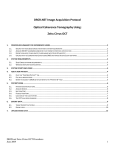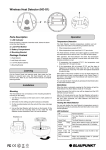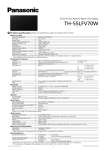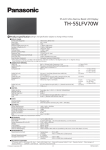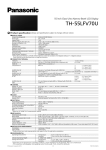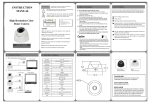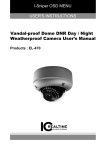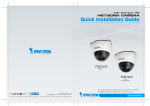Download User Manual
Transcript
Wireless Smoke Detector (SD-S1) Parts Description Corner, top of an “A” frame type ceiling, near ceiling beams or over a cabinet – The stagnant air may affect sensor sensitivity. 1. Learn/Test Button Operation Press the button to transmit a learn/test code, silence the alarm, test or recalibrate the Smoke Detector 2. LED Indicatorr Smoke Detection 3. Battery Compartment 4. Mounting Bracket Upon smoke detection, the Smoke Detector LED will flash, and the buzzer will sound to raise alarm. The LED flash and alarm will continue until smoke presence is removed. Package Content Alarm Silence 1 x Smoke Sensor with mounting bracket When the alarm is activated, pressing the learn/test button will put the Smoke Detector into Alarm Silence mode for 10 minutes. 2 x wall plugs and screws 4 x 1.5V alkaline batteries Learning Put the Control Panel into learning mode, then press the learn button to transmit learn code. Please refer to Control Panel manual to complete learn in process. Installation The Smoke Detector has 2 holes on the back cover for mounting on the ceiling. 1. Use the two holes on the back cover to mark position on the ceiling. 2. Drill holes into the ceilling using the holes as template. 3. Fix the base onto the wall with the screw and plugs provided. 4. Replace the cover onto the base. It is recommended to mount the Smoke Detector at center of ceiling. During this period, the built-in siren will be silenced and the LED will flash once per second. After the 10-minute period has expired, the Smoke Detector will emit 2 beeps and return to normal operation. If smoke presence is still detected, the Smoke Detector will raise alarm immediately again. Recalibrating the Smoke Detector Auto Calibration The operation condition of the Smoke Detector may vary sometime after installation, which may affect its smoke detection performance. In order to maintain its performance, the Smoke Detector will automatically recalibrate its sensor every month to ensure it is under optimal working condition. The Smoke Detector will not give any indication when it is performing auto calibration, unless the calibration process has failed. When auto calibration fails, the LED will flash to indicate. You can choose to: Remove and reload the batteries. The Smoke Detector will enter calibration process when batteries are inserted. Or, Manually recalibrate the sensor. The Smoke Detector will still function normally when auto calibration fails by using previous calibration’s setting. Manual Calibration Mounting Holes x 2 Follow below steps to manually recalibrate the Smoke Detector when auto calibration fails 1. Press and hold the learn/test button for 10 seconds until the LED begins to flash. 2. Release the learn/test button, the Smoke Detector will emit 2 short beeps. 3. The Smoke Detector is now under recalibration. The process takes about 2~16 minutes. When recalibration is complete, the Smoke Detector will emit 2 short beeps and the LED will turn off. 4. The Smoke Detector is now under normal operation. 5. If manual calibration still fails, the Smoke Detector will emit beeps, please remove the batteries, wait for 30 seconds then reload the batteries. Do not mount the Smoke Detector at the following locations Kitchen – The smoke from cooking may trigger false alarm. Near ventilating fan or air conditioner -- Air draft from them may affect sensor sensitivity Testing the Smoke Detector By pressing the learn/test button, you can test if Smoke Detector is functioning normally If the Smoke Detector is functioning normally, the LED will turn on for 2 Sec. It will then sound a 2-tone beep. If the buzzer sounds 3 beeps, it means the Optical Chamber in the Smoke Detector is either dirty or out-of-order. If the LED does not light up and no beep is sounded, it means the Smoke Detector is either out-of-order or battery depleted. LED Indicator Off On Slow Flash (every 30 seconds) Quick Flash Normal Operation Transmitting signal Low battery Self-calibrating process Battery The PIR uses four 1.5V alkaline batteries as its power source. It also features low battery detection function to notify the Control Panel when battery voltage is low. When the Smoke Detector is on low battery, follow the procedure below to change the batteries. 1. Detach the Smoke Detector from the mounting bracket. 2. Open the back cover. 3. Remove the old batteries. 4. Press the learn/test button several times to fully discharge. 5. Insert the new batteries observing correct polarity. The Smoke Detector will enter self-calibrating process for 8-22 minutes after inserting batteries. 6. Replace the back cover. 7. Replace the Smoke Detector on the mounting bracket Specification Environmental Condition -10°C to 40°C, relative humidity 85% non-condensing. Radio 433 MHz FCC Statement This device complies with Part 15 of the FCC Rules. Operation is subject to the following two conditions: (1) This device may not cause harmful interference, and (2) This device must accept any interference received, including interference that may cause undesired operation. FCC Caution: To assure continued compliance, any changes or modifications not expressly approved by the party responsible for compliance may void the user's authority to operate this equipment. (Example - use only shielded interface cables when connecting to computer or peripheral devices).


